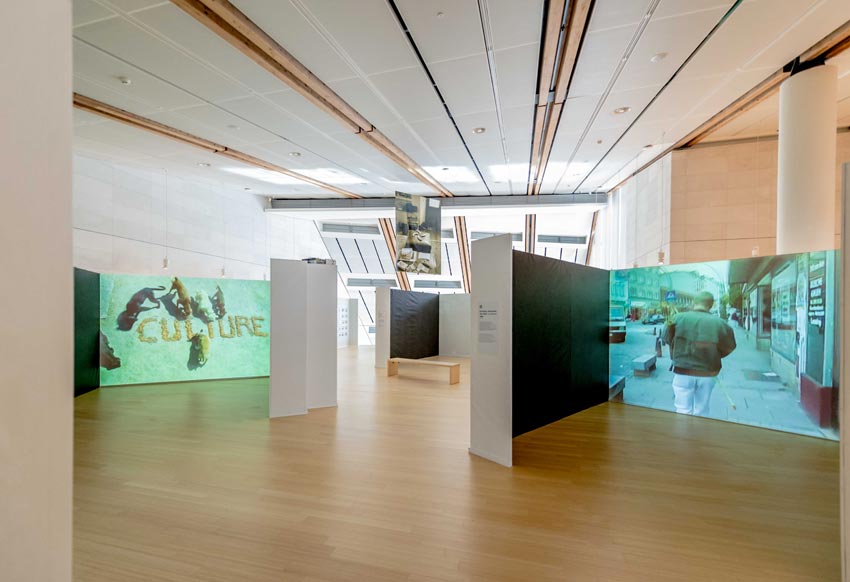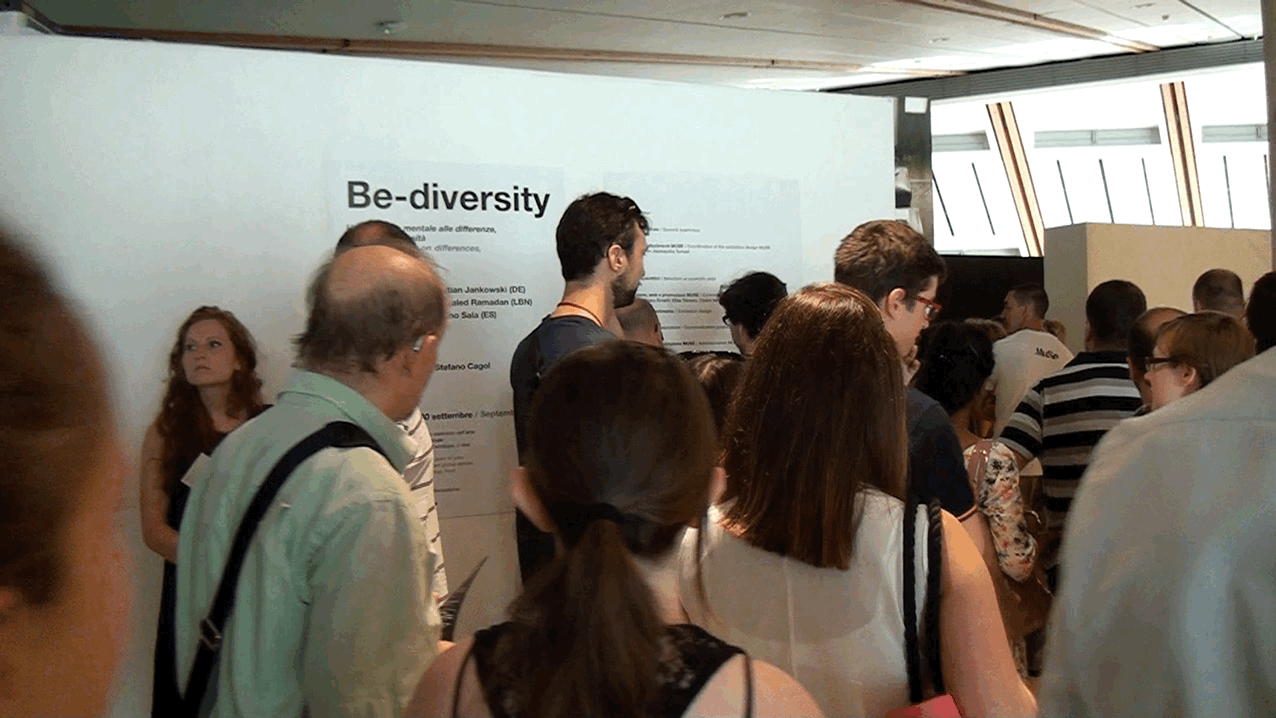
Be-diversity
MUSE
- Museo delle Scienze / Science Museum, Trento Luglio
/ July 18 – Settembre/ September 30, 2015
Science facts
Platform
Press
Home
Exhibition

Stefano Cagol, per la prima volta nella veste di curatore, entra negli spazi del MUSE Museo delle Scienze di Trento per mettere in comunicazione un variegato corpus di opere di affermati artisti internazionali, selezionate per la loro capacità di tematizzare argomenti come la biodiversità, la sostenibilità, l’ecologia, il cibo e il futuro del pianeta.
Fra le opere in mostra, alcune perle come il film Leave it in the ground (2013) di Oliver Ressler, che propone un approccio critico all'ecologia concentrando l’attenzione sull’influenza dello sfruttamento del mare e dei giacimenti di petrolio sulla pratica della pesca. L’opera, in anteprima in Italia nella sua versione sottotitolata in italiano, è stata ospitata quest’anno anche al Tromso International Film Festival (Norvegia). Sul tema dell’acqua si concentra anche il video (2015) dell'artista libanese Khaled Ramadan, già co-curatore di Manifesta 8, che riflette sui comportamenti delle comunità culturali legate alla natura e, quindi, influenzate dai suoi cambiamenti, come i pescatori cambogiani che appartengono alla minoranza musulmana Cham. La natura umana e le leggi dell’uomo influenzano la biodiversità: si muove su questo fronte l’esplorazione di The Order of Potatoes di Åsa Sonjasdotter. L’artista, che nel 2014 ha vinto il premio COAL per l’arte ambientale, si concentra da sempre sui temi della diversità, del potere, della conoscenza. Nel grande prato che abbraccia il MUSE e il cinquecentesco Palazzo delle Albere farà crescere, sotto gli occhi del pubblico in visita al Museo, particolari varietà di patate vietate all'interno dell'Unione Europea per la circolazione commerciale. La prospettiva di Avelino Sala instillerà nel visitatore una precisa domanda: la cultura fa mangiare? Nel video in mostra l’artista rappresenta un gruppo di cani che si ciba letteralmente della parola CULTURE (cultura). In questo dialogo fra opere si inserisce anche Giancarlo Norese con un’installazione tanto semplice quanto enigmatica. Nell’ironico video The Hunt (La caccia), di Christian Jankowski, invece, l’artista viene ripreso mentre si procaccia il cibo con arco e frecce all’interno di un supermercato, mentre il macchinario ideato da Wim Delvoye e chiamato Cloaca ricrea con estrema fedeltà il funzionamento di un apparato digerente.---
Stefano Cagol, for the first time working as curator, comes into the spaces of MUSE for put in contact a corpus of works by established international artists, selected for their skill to face topics such as biodiversity, sustainability, ecology, food and the future of the planet.
Among the exhibited artworks, some gems such as the film Leave it in the ground (2013) by Oliver Ressler, which proposes a critical approach to ecology focusing on the influence of the exploitation of the sea and oil deposits on fishing. The work, premiered in Italy in its version subtitled in Italian, has been showed this year also at the Tromso International Film Festival (Norway). On water focuses also the video (2015) by Lebanese artist Khaled Ramadan, former co-curator of Manifesta 8, which reflects the behaviour of cultural communities related to nature and, therefore, affected by its changes, as Cambodian fishermen belonging to the Cham Muslim minority. Human nature and the laws of man affecting biodiversity: the exploration of The Order of Potatoes by Åsa Sonjasdotter moves in this sphere. The artist, who won the award COAL for environmental art in 2014, has always focused on issues such as diversity, power, knowledge. In large lawn that embraces the MUSE and the sixteenth century Palazzo delle Albere are growing, under the eyes of the public visiting the museum, special potato varieties restricted in the European Union for the commercial use. The point of view by Avelino Sala instills in visitors a precise question: does culture make you eat? In the video the artist shows a pack of dogs that literally eat the word CULTURE (culture). In this dialogue between artworks, there is Giancarlo Norese’s installation, as simple as enigmatic. In the ironic video The Hunt by Christian Jankowski, however, the artist is shot while is procuring food with a bow and arrow in a supermarket, while the device realized by Wim Delvoye and called Cloaca recreates with extreme fidelity the process of a digestive apparatus.
Michele Lanzinger, direttore del MUSE:
“I
percorsi di conoscenza quelli che portano alla
consapevolezza e quindi all’azione, non sono sentieri che portano
isolati a questo o quel risultato. Non esiste una via biochimica,
matematica o naturalistica capace di portare verso una soluzione.
Se il metodo scientifico è lo strumento che ci permette di capire e di
prevedere i processi del mondo reale, la scelta di un modello da
perseguire non procede solo per definizioni o formule. L'esercizio
della critica, il riconoscimento di un orizzonte morale, la definizione
di uno scenario desiderabile, tutto ciò non è riconducibile alla sola
applicazione di algoritmi.
Il superamento di una cultura separata fra cultura scientifica e
umanistica è un retaggio da superare a favore di un meticciato capace
di dialogo tra fatti e progetti, tra desiderio e plausibilità.
Accogliere una sensibilità artistica all'interno di un museo delle
scienze è per questo, un esperimento pensato per attivare tutti i
sentieri di conoscenza che la cultura sa produrre”.
"The paths of knowledge - the director of MUSE, Michele
Lanzinger, says - that lead to awareness and then to action, are
not trails that reach this or that result in an isolated way. There
isn’t the way of biochemistry, of mathematics, of nature that could
lead to a solution. If the scientific method is the tool that allows us
to understand and predict the processes of the real world, the choice
of a model to be pursued has to be made not only using definitions or
formulas. The exercise of criticism, the recognition of a moral
horizon, the definition of a desirable scenario, this is not due only
to the application of algorithms.
The idea of separated scientific culture and humanistic culture is
a legacy to be overcome in favour of a dialogue of interbreeding
between facts and projects, including desire and plausibility. So
hosting artistic sensibility in a science museum is an experiment
devoted to enable all paths of knowledge that culture knows how to
produce."
